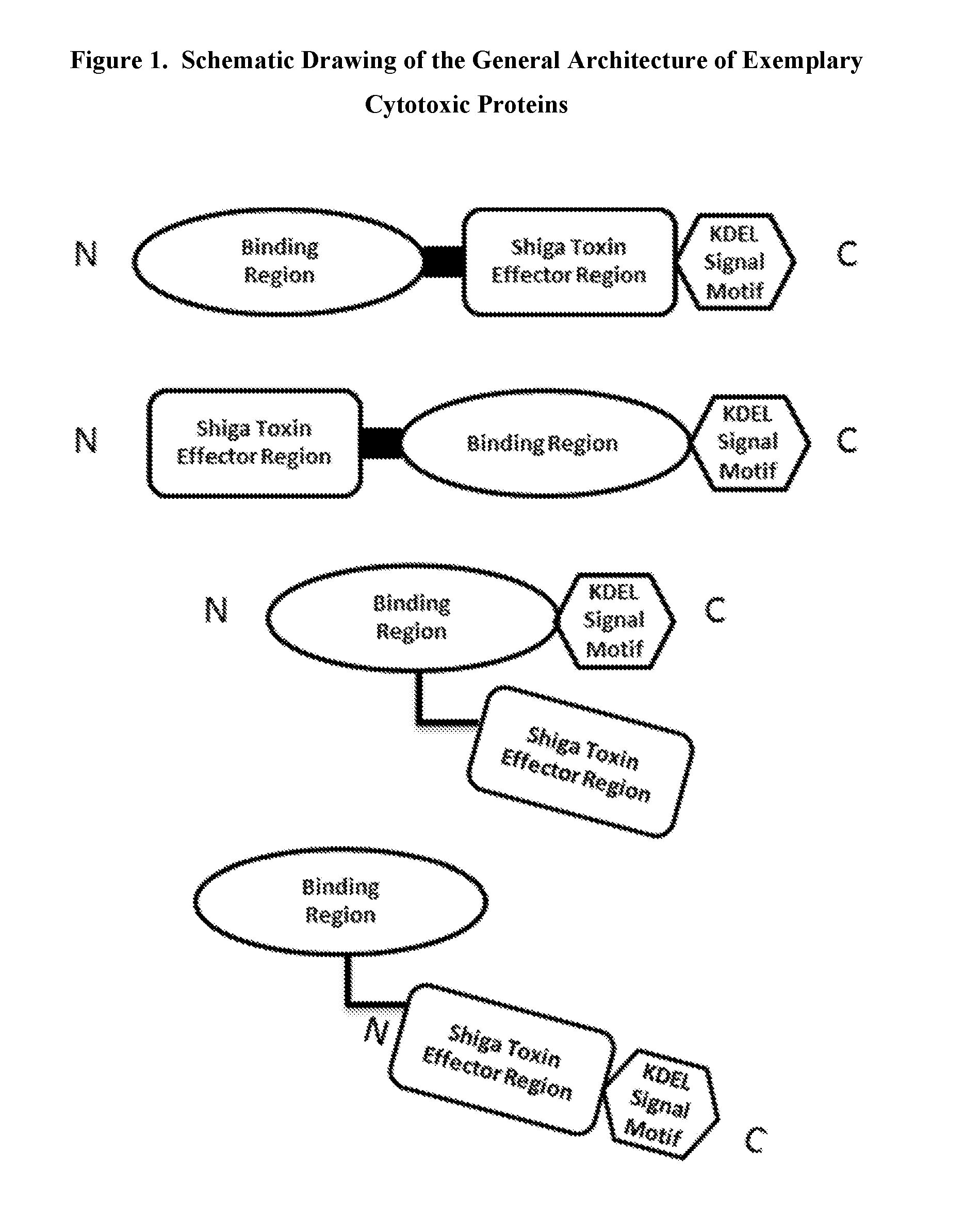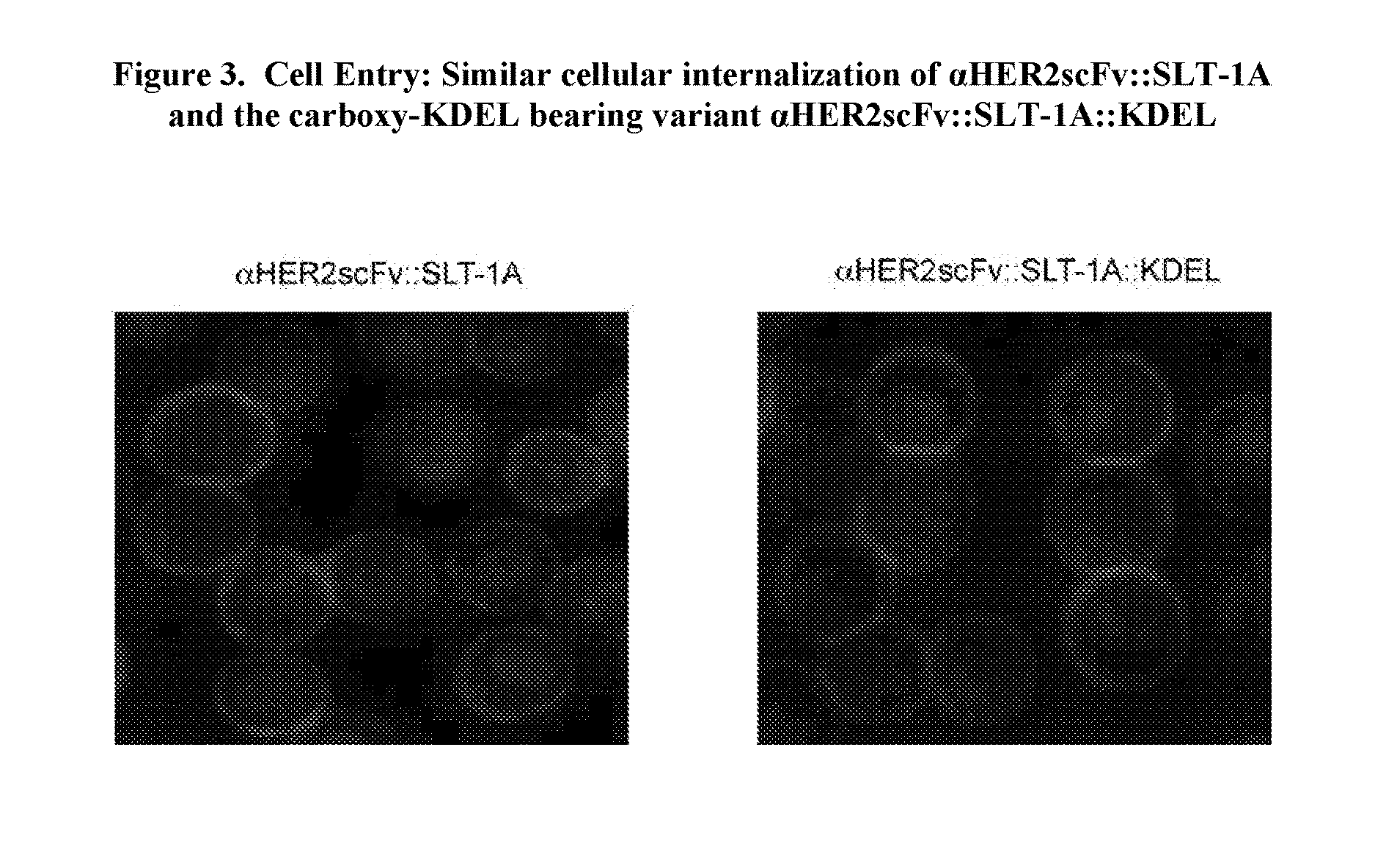Proteins comprising binding regions, shiga toxin a subunit effector regions, and carboxy-terminal, endoplasmic reticulum localization signal motifs
a technology of carboxy-terminal endoplasmic reticulum and binding regions, which is applied in the direction of antibacterial agents, immunological disorders, metabolism disorders, etc., can solve the problem of inability to detect the activity of inability to detect shiga toxin effector functions, and inability to achieve accurate values for icsub>50 /sub>or cdsub>50 /sub>, etc. problem, to increase the effect of cytotoxicity
- Summary
- Abstract
- Description
- Claims
- Application Information
AI Technical Summary
Benefits of technology
Problems solved by technology
Method used
Image
Examples
example 1
A HER2-Targeted, Cytotoxic Protein Derived from Shiga-Like Toxin 1 A Subunit with an Endoplasmic Reticulum Signal Motif (αHER2scFv::SLT-1A::KDEL)
[0277]The cytotoxic protein of this example αHER2scFv::SLT-1A::KDEL comprises a single-chain, variable fragment, binding region capable of binding HER2 with high affinity combined with a Shiga toxin A Subunit fragment and a carboxy-terminal KDEL motif.
Construction, Production, and Purification of the Cytotoxic Protein αHER2scFv::SLT-1A::KDEL
[0278]First, a Shiga toxin effector region and a binding region were designed or selected. In this example, the Shiga toxin effector region was derived from the A subunit of Shiga-like Toxin 1 (SLT-1A). A polynucleotide was obtained that encoded amino acids 1-251 of SLT-1A (Cheung M et al., Mol Cancer 9: 28 (2010)). An immunoglobulin-type binding region αHER2scFv was derived from trastuzumab (marketed as Herceptin®, Genentech, Inc., South San Francisco, Calif., U.S.) and the 4D5 monoclonal antibody (Zhao...
example 2
A CD38-Targeted, Cytotoxic Protein Derived from Shiga-Like Toxin 1 A Subunit with a Carboxy-Terminal Endoplasmic Reticulum Signal Motif (αCD38scFv::SLT-1A::KDEL)
[0295]The cytotoxic protein of this example αCD38scFv::SLT-1A::KDEL comprises a single-chain, variable fragment, binding region capable of binding CD38 with high affinity combined with a Shiga toxin A Subunit fragment and a carboxy-terminal KDEL motif.
Construction, Production, and Purification of the Cytotoxic Protein αCD38scFv::SLT-1A::KDEL
[0296]In this example, the Shiga toxin effector region was derived from the A subunit of Shiga-like Toxin 1 (SLT-1A). A polynucleotide was obtained that encoded amino acids 1-251 of SLT-1A (Cheung M et al., Mol Cancer 9: 28 (2010)). An immunoglobulin-type binding region αCD38scFv was derived from the monoclonal antibody anti-CD38 HB7 (Peng et al., Blood 101: 2557-62 (2003); see also GenBank Accession BD376144, National Center for Biotechnology Information, U.S.) such that a single-chain v...
example 3
A CD19-Targeted, Cytotoxic Protein Derived from the a Subunit of Shiga-Like Toxin-1 (αCD19scFv::SLT-1A::KDEL)
[0313]The cytotoxic protein of this example αCD19scFv::SLT-1A::KDEL comprises a single-chain, variable fragment, binding region capable of binding CD19 with high affinity combined with a Shiga toxin A Subunit fragment and a carboxy-terminal KDEL motif
Construction, Production, and Purification of the Cytotoxic Protein αCD19scFv::SLT-1A::KDEL
[0314]First, a Shiga toxin effector region and an immunoglobulin-type binding region were designed or selected. In this example, the Shiga toxin effector region was derived from the A subunit of Shiga-like Toxin 1 (SLT-1A). A polynucleotide was obtained that encoded amino acids 1-251 of SLT-1A (Cheung M et al., Mol Cancer 9: 28 (2010). An immunoglobulin-type binding region αCD19scFv was derived from the humanized monoclonal antibody anti-CD19 4G7 (Peipp M et al., J Immunol Methods 285: 265-80 (2004) and references therein) such that a singl...
PUM
| Property | Measurement | Unit |
|---|---|---|
| dissociation constant | aaaaa | aaaaa |
| density | aaaaa | aaaaa |
| pharmaceutical composition | aaaaa | aaaaa |
Abstract
Description
Claims
Application Information
 Login to View More
Login to View More - R&D
- Intellectual Property
- Life Sciences
- Materials
- Tech Scout
- Unparalleled Data Quality
- Higher Quality Content
- 60% Fewer Hallucinations
Browse by: Latest US Patents, China's latest patents, Technical Efficacy Thesaurus, Application Domain, Technology Topic, Popular Technical Reports.
© 2025 PatSnap. All rights reserved.Legal|Privacy policy|Modern Slavery Act Transparency Statement|Sitemap|About US| Contact US: help@patsnap.com



